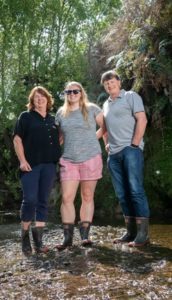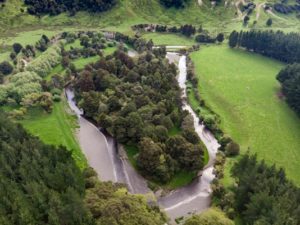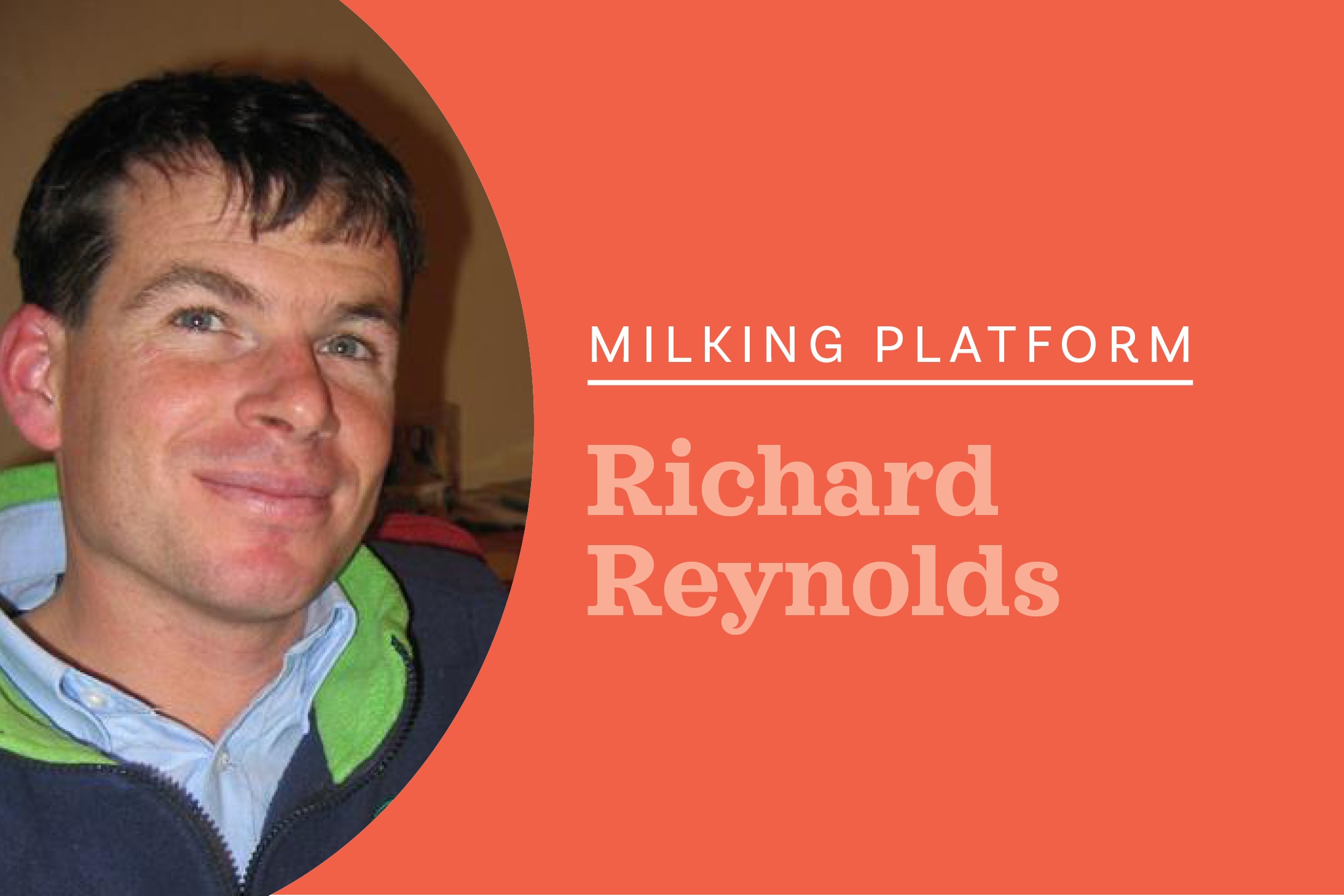A Dannevirke couple have developed an award-winning dairy farm in the midst of sheep and beef country. Jackie Harrigan reports.
Andrew Hardie and Helen Long scoured the country from Kaitaia to Bluff when looking for a farm to buy or invest in; they ended up buying in to the flattest farm in a sheep and beef area a stone’s throw from where Andrew grew up, east of Dannevirke.

Photos: Brad Hanson
Half the farm, split off Ben Nevis station, was converted to dairy and the other half still running deer on the block bordered by two rivers, the upper Manawatu and the Maungatewainui when they bought into it as an equity partnership with four other parties.
Right away the Hardies appreciated the sensitive nature of the Manawatu catchment and their property, calling it their ‘little piece of paradise’, and they set about developing and conserving the farm for their family’s future.
Their work of the past 19 years has won them the Supreme Award in the Ballance Farm Environment Awards for the Horizons region for 2018, picking up the DairyNZ Sustainability and Stewardship Award, Hill Laboratories Agri-Science Award and WaterForce Integrated Management Award.
“It’s an exciting area to farm – we are lucky to have the only flat area between the confluence of the two rivers and a nice mix of country,” Andrew says.
“The land was cheaper because of the lower rainfall, with terraces along the river, then old alluvial terraces and rolling areas.”
“We can irrigate 130ha for four months out of the Mangatewainui River – it depends on the season but we usually start in mid-November and we will go through to mid-February.”
‘It’s an exciting area to farm – we are lucky to have the only flat area between the confluence of the two rivers and a nice mix of country.’
Sometimes they get rain events that mean they can turn off the pivot and laterals irrigation system, but otherwise they monitor the season fairly closely – between their rain records, NIWAs virtual weather station at the property and digging holes they can follow the evapotranspiration rate and keep a water balance profile based on the soil type and contour to help manage irrigation efficiency.
If we water for 100 days, we can apply 3-3.5mm/day – that’s what our system can do.”
The farm is mainly recent alluvial soils with sandy silt loams, and 1/3 of it yellow-brown clay soils which have extensive moles and drainage from all the springs coming up through the property.
Non-productive areas have been retired over the years and more productive areas intensified and as the dairy platform grew, production has tripled off the property.
“It been about doing things as we could afford to – if we were regrassing we fenced off and retired areas, drained other bits, giving every area the best chance we could of it surviving and thriving.”
“The class of land that we could get a tractor over and cultivate it and get it into new grass, we have done – and we have fenced off the other areas because it makes economic sense and increases biodiversity and aesthetic appeal.”
Armed with agriculture degrees from Massey University Andrew and Helen had worked their way through the sharemilking system to be running two 50/50 jobs and knew exactly what they wanted to do when they settled down to the Te Maunga equity partnership.
Regenerating native bush areas, developing wetlands, retiring areas with permanent fencing, planting pines and over 1000 riparian plants annually and covenanting a QE II area over the years has increased biodiversity and the aesthetics of the property while limiting loss of fertility.
In latter years a formal farm plan was developed – in the early years they developed as they could, using their knowledge and common sense, they said.
“By intensifying the better areas that were worth investing in, we could retire others.”
Cow numbers have waxed and waned, peaking at 880 cows on twice-a-day milking and extra land, owned and leased – so 10 years ago they consolidated, gave up a lease block and sold a 90ha parcel and moved to OAD.
This year they have peak milked 650 cows and produced almost the same amount of milk.
‘We were chasing our tails a bit on twice-a-day – now we are much lower input, and on the low-cost system we are increasing profitability, with less stress and reduced N inputs.
The couple went through the consenting process under the One Plan when it was first installed and were one of the first farms to be consented under Table 14.1. Benchmark year was 2012 with 45kg N/ha leached, and this year the level has dropped to below 30kg/ha.
Dropping cow numbers, reducing N applied and using coated N products, increasing the effluent pond area and being more strategic around when the effluent is applied to the 40-50ha effluent area through a travelling irrigator and above ground pipes has all contributed to the dropping n leaching level.
“We were reasonably low by industry standards anyway due to the low rainfall, but the simple system we have adopted has allowed us to reduce further. Cutting out the turnip crops has helped – research showed that strip grazing of turnips caused a huge nutrient dumping on the area, and then a rainfall event caused leaching. Plus we found when the summer turned dry and we really needed the turnips, they suffered and didn’t grow well because of the lack of water. Moving to 24ha of chicory, plantain and clover crop each year means the cows move through on a 18-day round and the crop uses the N.
“On the base year we were applying a 190kg N/ha and our strategy is to apply 115kg N/ha, we actually only applied 90 last year. Plus we have our own spreader and can pick and mix the time of application – we can do it ourselves or get the fert spreader in and get it all on if the conditions are perfect.
“Timely application is quite critical.”
The difference between the top 50% and the top 10% of farmers is not what they do, but the timing of it – we have really concentrated on getting the timing right over the years.”
Bought-in supplements of maize silage, palm kernel and hay have been reduced, now cows are wintered at home on 10-12ha of fodder beet.
Fodder beet can be tricky, Andrew say, both to grow and graze, but he is happy with a yield of 30t/ha if they can get it.
“It’s a bit more expensive if we only get 20t/ha, but we usually get more than that.”
With grazing, leaving cows on the beet destroys the soil structure, and impacts the cows health standing in the mud, he says,
But by having them on the beet for just a few hours they get the benefit, then move to the grass for a few hours and then move to the standoff pad if its really wet and get fed hay there. If the weather is not wet they can stay on the grass.
It’s a versatile crop, says Andrew.
“The last couple of years we have started grazing it with the milkers at the end of the season. It can extend the lactation and build cow condition going into winter. If the cows are in good order at drying off they are easy to winter, she is already used to the beet and there is no transition period.”
“We still buy in a little bit of palm kernel, but we have a lot of flexibility in the system – we can buy in or not.”
Andrew and Helen have recently bought a support block at Waimarama, in Hawke’s Bay, with 40ha of pasture for young stock and beefies, a scrub block which they plan to let revert and plant up into a 20ha ETS-registered carbon sink and a beautiful house site with a coastal view which will be Andrew and Helen’s retirement spot as they step back from the farm over the next five years.
Having bought out their equity partners after 15 years of the partnership, the couple then brought on the Richardsons as contract milkers. Liam and Margot are a real asset to our farm and business, being passionate and holistic about the environment and the dairy industry. Moving to sharemilkers is the next step, so they can concentrate more on off-farm governance and community initiatives.
Sustainability has always been their aim, and they say it means longevity and balance across the physical environment, their business and the people within it.
“We feel we are the custodians of this little patch of New Zealand and whether we hold it for our three children or someone else’s children, it is our responsibility to value it and enhance it.”
Once-a-day milking benefits
Te Maunga farm is long and narrow with a 5.5km walk from the back of the farm and the long walk and the toll it took on cows prompted Andrew and Helen to look at the once a day milking option in 2008.
The couple were both taught at Massey by OAD guru Dr Colin Holmes and were invited to join his early OAD discussion group.
Once-a-day milking enabled them to address the 8% level of lame cows and reduce staffing levels.
“We used to farm with four permanent staff and casuals for 820 cows, and seemed always to be looking for staff, now we have a contract milker and two staff and life is much less pressured and more enjoyable for us.”
Most afternoons work is all finished by 4pm and in the weekends the staff are out the gate by 9-10am.
“The staff can be finished and back in town by the time their mates are waking up.”
Reproduction has improved, with empty rates dropping from 13% to between 3-8%, allowing them to shorten their mating period to six weeks of AI and three weeks of follow-up bull. The top 2/3 of cows are mated for replacements and the bottom 1/3 get Wagyu semen and the calves are sold under contract at 90kg.
While the lactation doesn’t peak as high under OAD, longer days in milk means the farm is producing slightly ahead of the district average per cow with higher good profitability under the low cost and low input system.
Water quality and efficiency
The family have invested in a large effluent storage area and a composting standoff area to make efficient use of nutrients and limit winter damage to the heavier soils on the farm.
Constructed with a thick liner covered with 150 mm of pea metal, a carpet membrane and 400mm of wood chip, the area comfortably holds 400 cows who are able to feed on balage and hay from racks between time spent in winter feeding on fodder beet and pasture.
About 350 cows will spend 60/80 days on the area through winter from late May.
“The positive effects on the soils mean much higher grass growth and the cows enjoy the warmth and dryness of the composting area.
The composted woodchip is scraped off and replaced very couple of years and incorporated into a crop paddock.
The drainage from the standoff area runs into the effluent system, and green water recycled as yard washdown before being pumped out onto the 40-50ha effluent irrigation area.
“We can often drag the hose over to put effluent onto cropping areas too – adds to the nutrients applied,” Andrew says.
“Water is not only a scarce resource, it’s expensive to pump around so we decided when we came here that we would have simple infrastructure to make the most of the resource. Water is pumped up to a tank once and then recycled through the flood wash for cleaning and all run off is captured in the effluent system.”
Wetlands have been developed around the farm with Helen and Andrew finishing the development of one area and starting another this season.
“Our plan is to control the exit of all runoff from our property through the four distinct water courses that leave it so that each creek or water course leaves through a wetland or sediment trap – so only filtered, N-reduced and settled water leaves the property into the river.”
Lord of the Rings open air covenant
An open-air covenant has recently been approved for an area of significant natural beauty on the property the family call ‘the Lord of the Rings’. The areas is in a bend of the Mangatewainui River, over a steep siding with attractive large weathered limestone outcrops with grass and trees and an unworldly air.
By excluding the 10ha paddock from grazing the family are protecting the limestone and area from erosion.
Source to Sea project
Helen and Andrew have been working on a plan for the Mangtewainui catchment under the umbrella of the Manawatu River Source to Sea project, a whole-of-catchment approach to enhancing biodiversity.
There are 145 properties in the catchment between the Ruahine ranges and the Manawatu river, and their vision is to see them all working together to protect and enhance the biodiversity and water quality, and eventually have a path for the community to walk, cycle, swim and even stay overnight in accommodation banks of the river.
The Source to Sea project brings together the many catchment care initiatives already found in the Manawatu River catchment, on both sides of the Ruahine ranges. The vision out to 2040 is an integrated network of biodiversity-focused initiatives, including sustainable business and nature-related activities, collectively contributing to the enhancement of biodiversity to provide benefits to the whole catchment community.
Step one is full stock exclusion, step two planting and weed and pest eradication with step three being access for the public, she explained.
“All of our stock water and water from the houses comes from the Mangatewainui, so we decided very early on that we needed to fence it off, protect it and maintain shade on the margins to regulate the temperature and maintain water quality.”
Andrew is a member of the Fonterra Shareholders Council.
Farm facts
Te Maunga Farms Ltd
Total area: 428ha (240ha milking platform, 83ha attached runoff, 42ha managed pines, 35ha riparian planting, 28ha shelter trees/races/native trees/ house/farm buildings.
35% farm relatively flat, balance rolling plus steeper sidlings.
130ha irrigated with 45 ha centre pivot, 85ha long laterals
Rainfall: 800-1000mm
Elevation: 205-310asl
50 bail rotary dairy
Cows: 700 MA Jersey cross OAD cows, replacement heifers and calves.
Fonterra supply: 235000-245,000 kg MS (1000kg MS/ha, 342kg MS/cow)
System two: 250t palm kernel and some hay bought in.
FWE: $2.00/kg MS
Contract milkers: Liam and Margot Richardson





